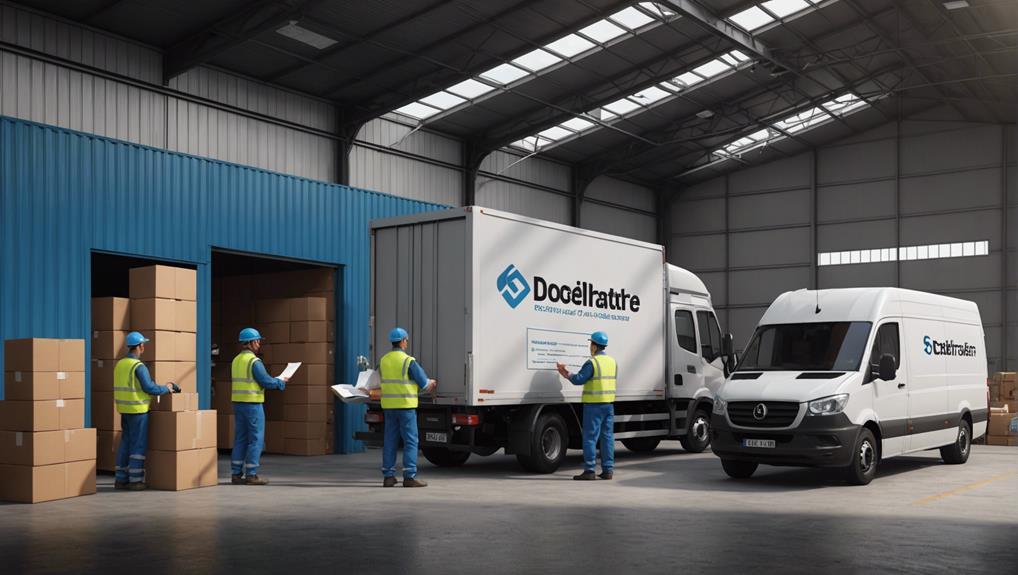Delivered-at-Place (DAP) Definition, How It Works, and Obligations
Delivered-at-Place (DAP) is an Incoterm that sets out the division of risks and duties in global trade transactions. The seller shoulders risks until goods reach the designated location, managing transport and loading, while the buyer takes over import clearance and unloading responsibilities. Sellers must mitigate risks, cover costs, and provide accurate documentation, while buyers handle clearances, compliance, and responsibilities upon goods' arrival. Incoterms are vital in defining roles to avoid disputes, with DAP differentiating from DDP by shifting responsibilities at a specified point. Understanding DAP is essential for efficient and transparent international trade operations.
Key Takeaways
- DAP shifts risks to buyer upon goods' destination.
- Seller manages loading, transport, and packaging costs.
- Buyer handles import clearance and unloading.
- Seller covers shipment costs and potential losses.
- DAP crucial for efficient and transparent trade operations.
Delivered-at-Place (DAP) Origins
The inception of the Delivered-at-Place (DAP) Incoterm in 2010 marked a pivotal moment in international trade, streamlining the transfer of responsibilities and risks between buyers and sellers at specified delivery locations.
The origins of DAP can be traced back to the need for a thorough and universally applicable term that clarifies the obligations of parties in a trade contract. This Incoterm evolved from the previous term, Delivery Duty Unpaid (DDU), to provide a more structured framework for global trade operations.
The evolution of DAP signifies a shift towards greater transparency and efficiency in international transactions, ensuring smoother logistics and reduced uncertainties for both sellers and buyers.
DAP Working Mechanism Explained
Upon reaching a specified location, the Delivered-at-Place (DAP) mechanism entails the seamless transfer of responsibilities and risks between the seller and buyer in international trade contracts.
- Risk Allocation: DAP places the risk on the seller until goods reach the designated place, ensuring a clear delineation of responsibility.
- Shipment Process: The seller manages packaging, loading, and transport costs, while the buyer takes charge of import clearance and unloading upon arrival.
- Financial Responsibility Transfer: DAP specifies the exact point where financial obligations shift from the seller to the buyer, streamlining the transaction process for both parties.
In understanding the DAP working mechanism, it becomes evident how risk allocation and the shipment process are pivotal components in ensuring a smooth and efficient international trade operation.
Seller's DAP Obligations
Initiating the process of international trade under the Delivered-at-Place (DAP) terms necessitates the seller to undertake a series of essential obligations. The seller's obligations under DAP include meticulous risk management by covering shipment costs and potential losses until the goods reach the agreed-upon destination.
Additionally, documentation requirements are vital, as sellers must provide accurate documentation such as tallies, invoices, and packaging details. It is the seller's responsibility to obtain export licenses and handle customs issues, ensuring a smooth shift of goods.
Managing pre-carriage, loading, and delivery to the destination falls under the seller's purview, emphasizing the need for thorough risk assessment and efficient handling of documentation to uphold the DAP agreement.
Buyer's DAP Responsibilities
Under the Delivered-at-Place (DAP) terms, the buyer assumes specific responsibilities upon the arrival of the goods at the designated location.
- Buyer's Documentation Requirements:
- The buyer must make sure all necessary documentation is in order for customs clearance.
- Import Clearance Process:
- Upon the goods' arrival, the buyer is responsible for managing the import clearance process efficiently.
- Compliance with Regulations:
- It is essential for the buyer to adhere to all import regulations and requirements to facilitate a smooth clearance process.
Incoterms' Role in DAP
The integration of Incoterms plays an essential role in defining the precise responsibilities and obligations within the framework of Delivered-at-Place (DAP) transactions. Incoterms have evolved since their establishment by the International Chamber of Commerce in 1936 to facilitate both domestic and international trade. They provide a standardized set of rules that outline the duties of buyers and sellers, ensuring clarity in financial contracts. The evolution of Incoterms has simplified the application of terms like DAP universally, regardless of the mode of transport used. Understanding and adhering to these Incoterms is vital to avoiding disputes and legal issues, thereby carrying significant trade implications.
| Incoterms Evolution | Trade Implications |
|---|---|
| Standardized rules established in 1936 | Ensures clarity in financial contracts |
| Simplifies application universally | Avoids disputes and legal issues |
| Facilitates both domestic and international trade | Significant trade implications |
Key Differences: DAP Vs. DDP
In comparing Delivered-at-Place (DAP) with Delivery Duty Paid (DDP) in international trade contracts, distinct differences in the distribution of responsibilities between the buyer and the seller emerge.
- Risk Allocation:
- DAP: Seller bears risks until goods reach the agreed place.
- DDP: Seller assumes all risks throughout the entire journey.
- Cost Distribution:
- DAP: Buyer handles import duties, taxes, and clearance upon arrival.
- DDP: Seller covers shipping, insurance, duties, and expenses.
- Responsibility Transfer:
- DAP shifts responsibility from the seller to the buyer upon arrival at the designated place.
- DDP maintains seller responsibility for the shipment until delivery is completed.
The Significance of DAP in Trade
Signifying a pivotal shift in international trade practices, Delivered-at-Place (DAP) emerges as a meticulously defined Incoterm outlining distinct roles and obligations between buyers and sellers in global commerce.
The significance of DAP in trade lies in its importance in clarifying responsibilities and risks between trading parties. DAP guarantees a smoother transaction process by clearly defining where the seller's obligations end and where the buyer's responsibilities begin. This clarity reduces misunderstandings, disputes, and potential delays in the shipment process.
The benefits of DAP include providing a standardized framework for international trade agreements, promoting efficiency in logistics planning, and enhancing overall transparency in global trade relationships. By outlining specific tasks and liabilities, DAP contributes to a more structured and reliable trading environment.
Conclusion
To sum up, the Delivered-at-Place (DAP) Incoterm has revolutionized international trade agreements by clearly outlining the responsibilities of sellers and buyers in the movement of goods.
A study by the International Chamber of Commerce found that DAP accounted for 28% of all global trade contracts in 2020, highlighting its widespread adoption and importance in the modern trade landscape.







